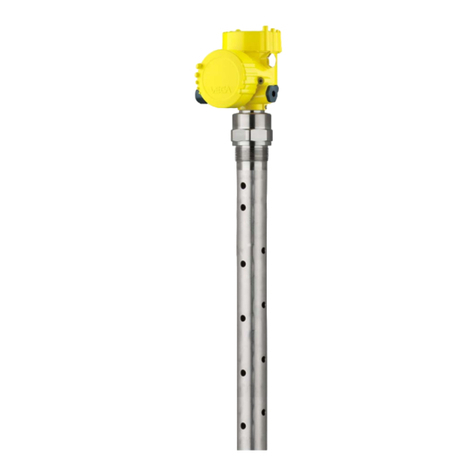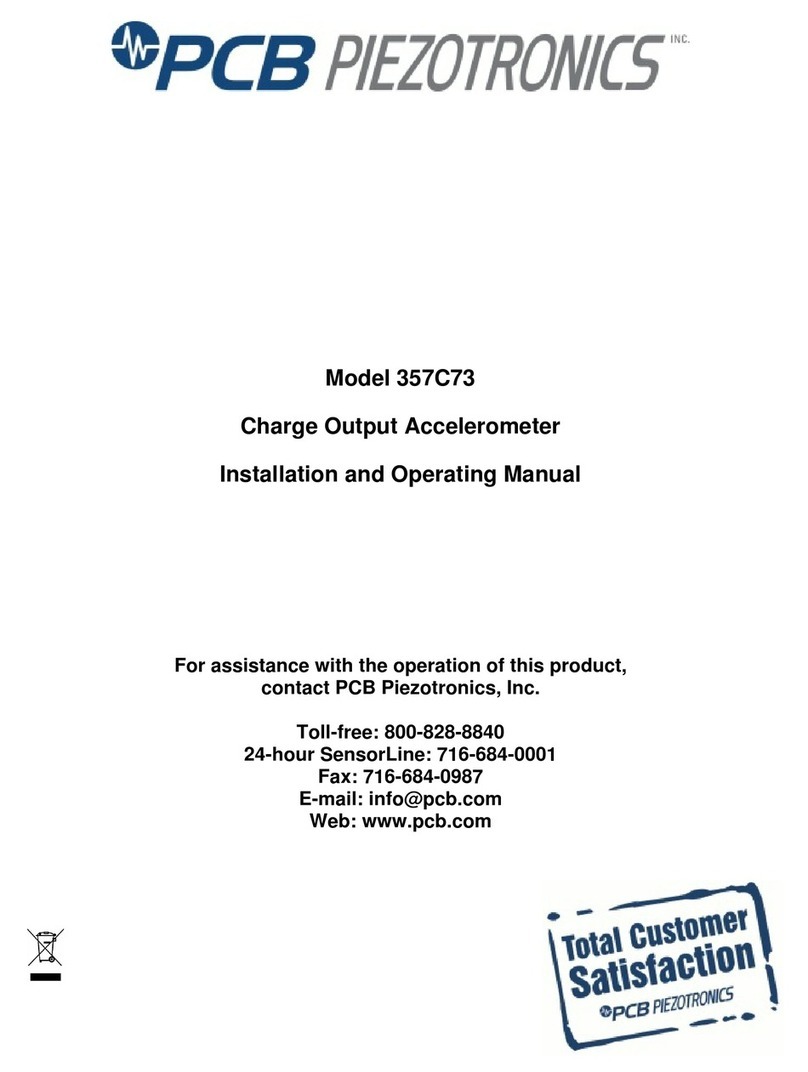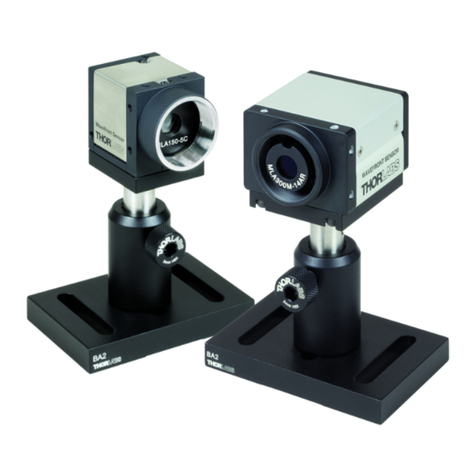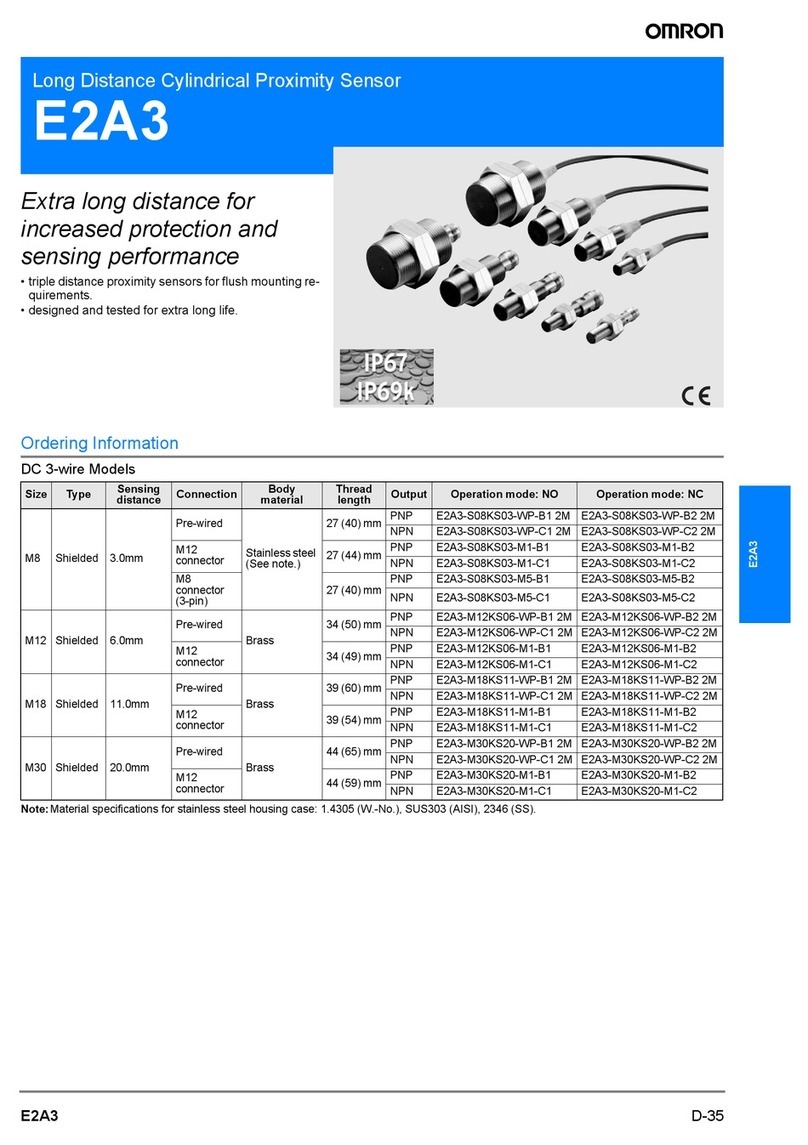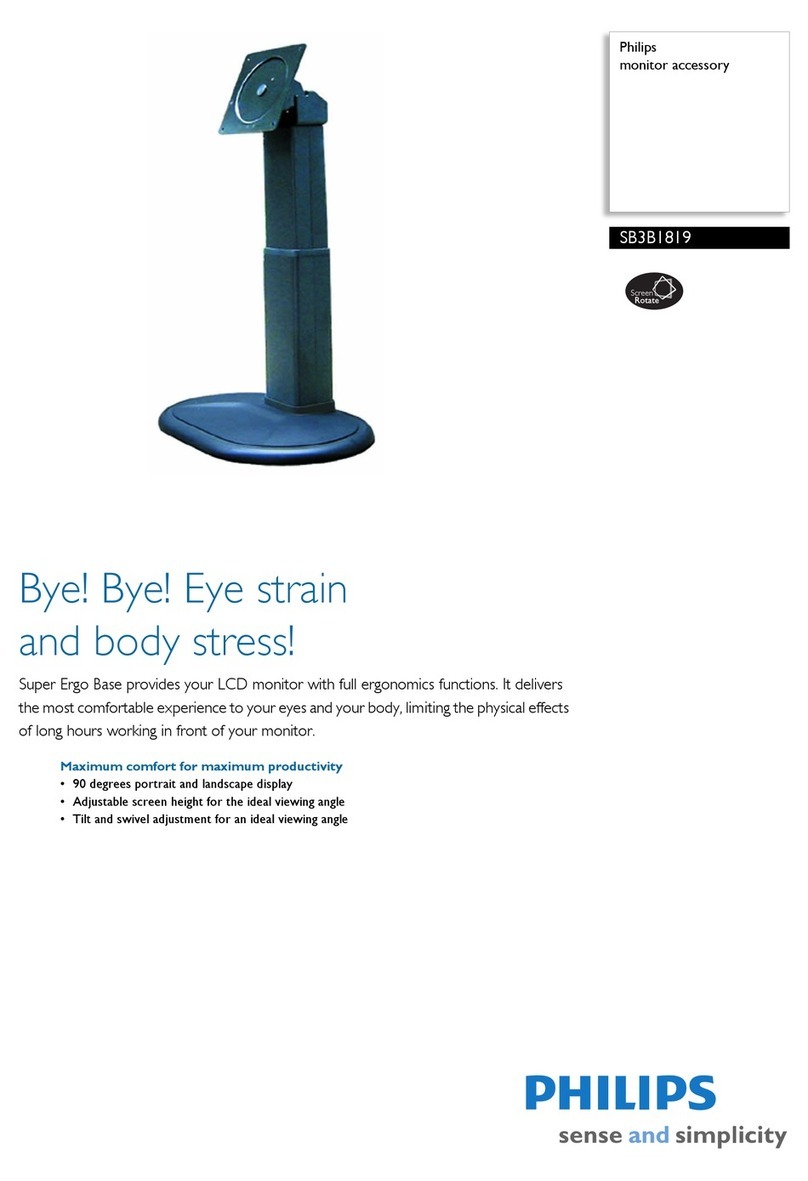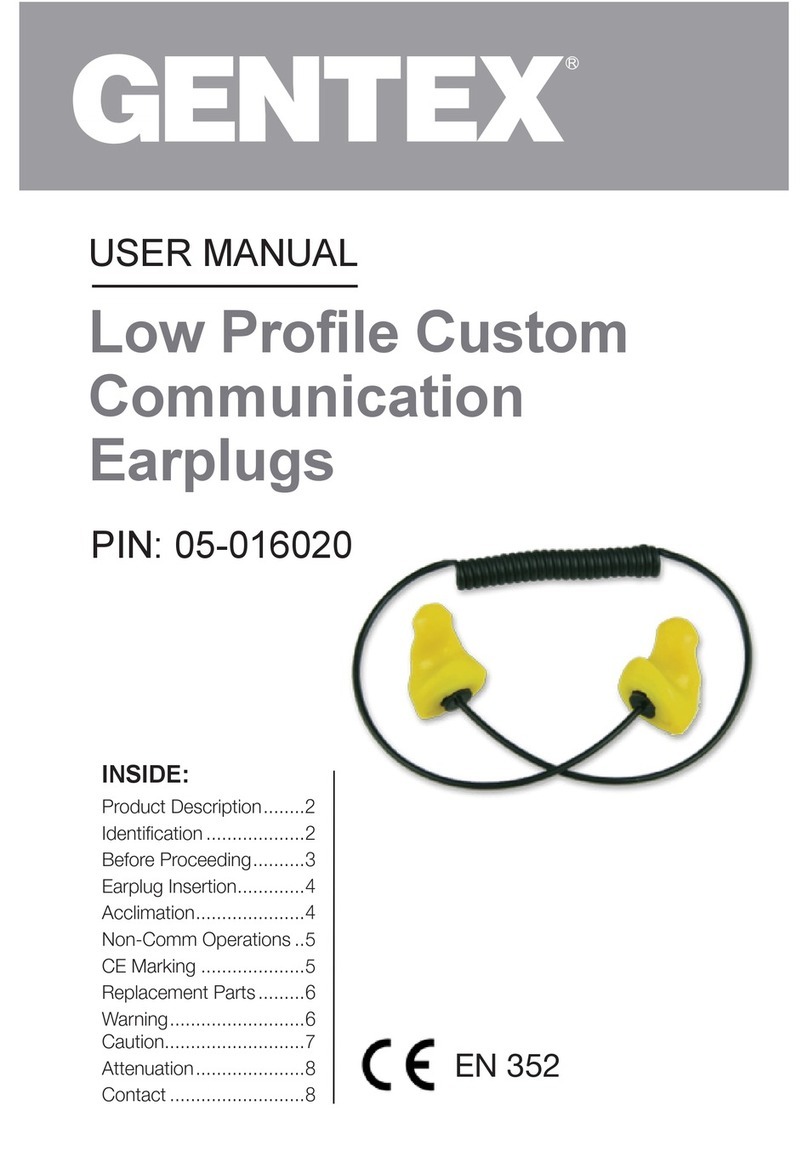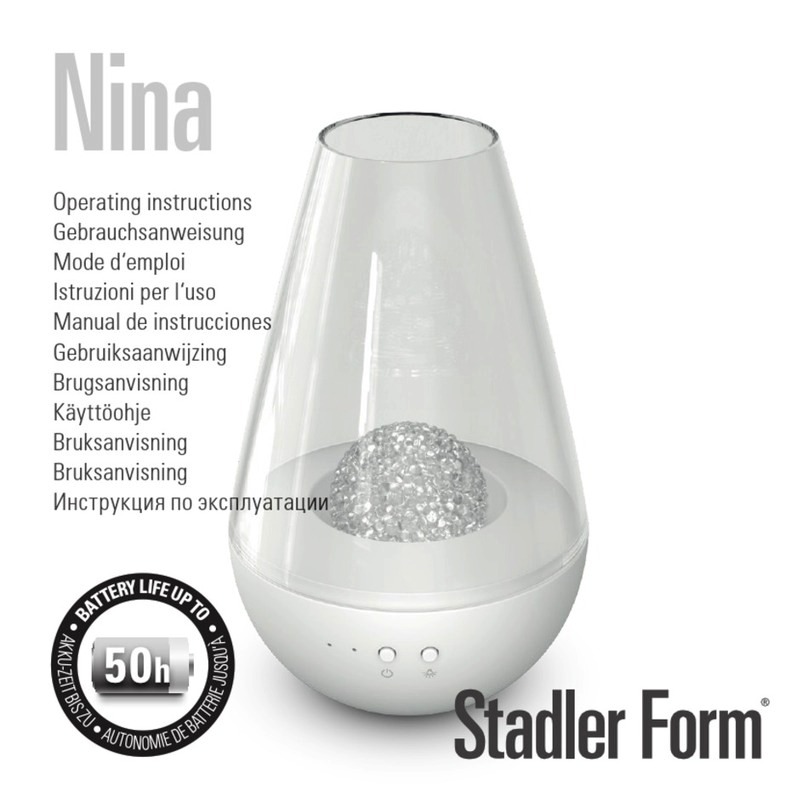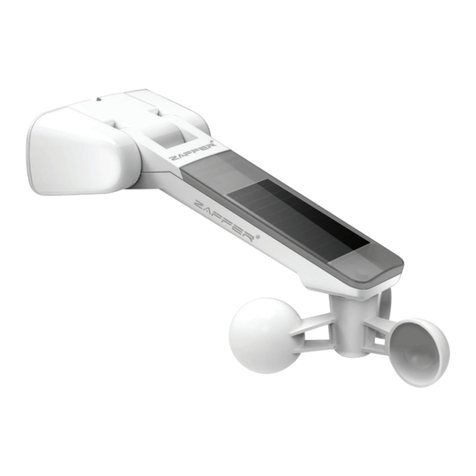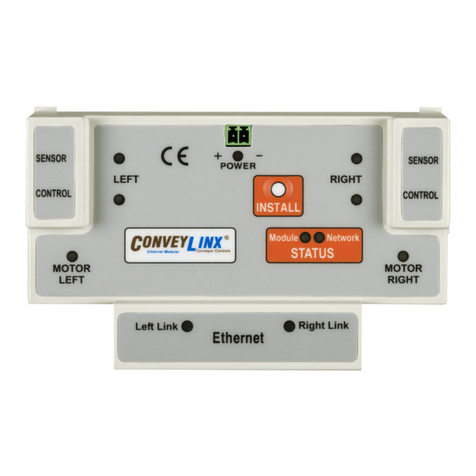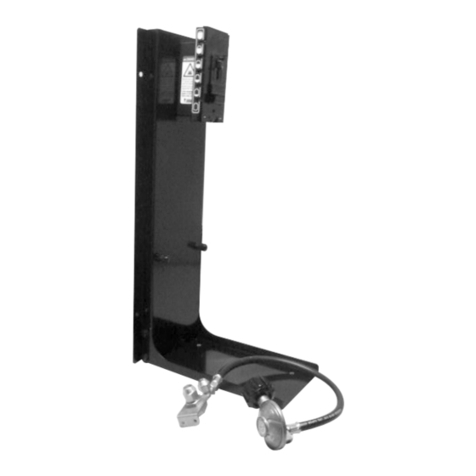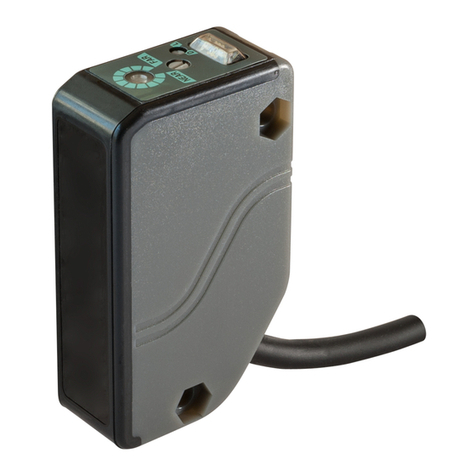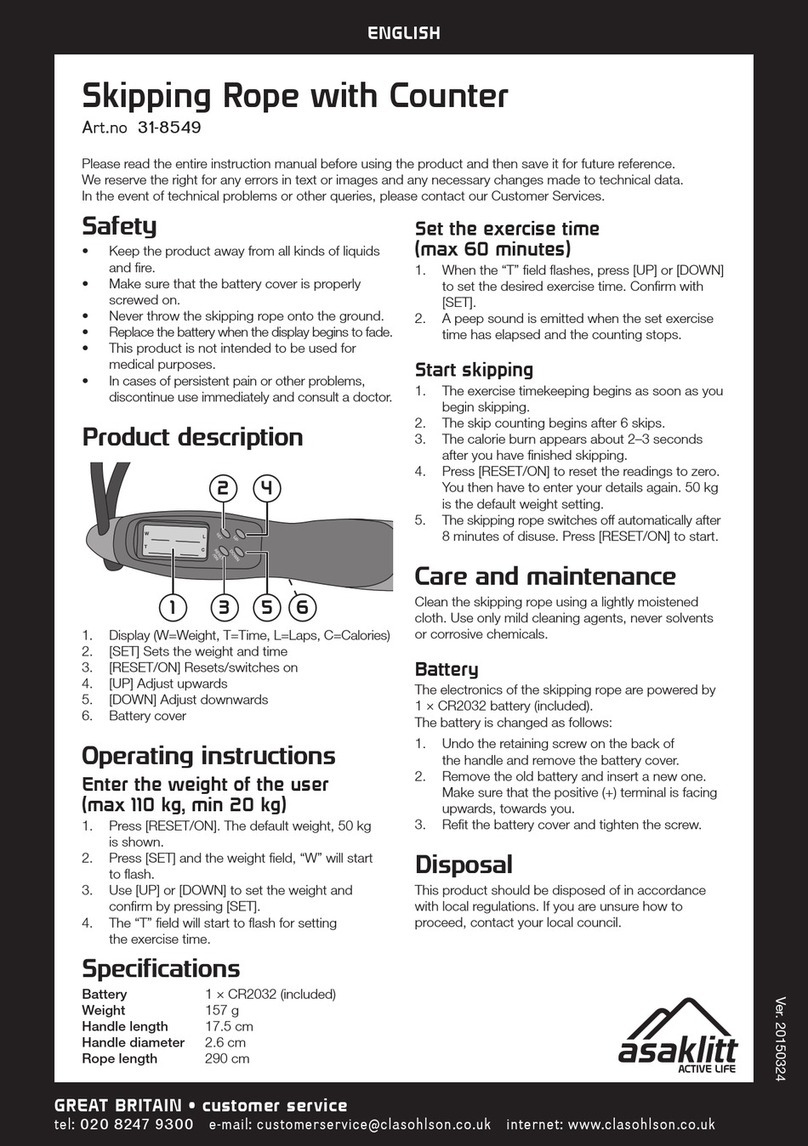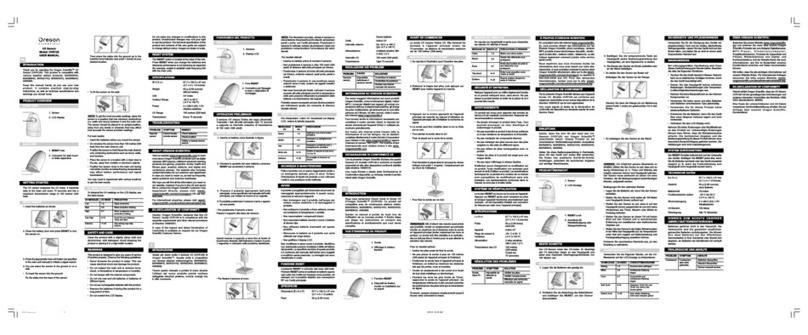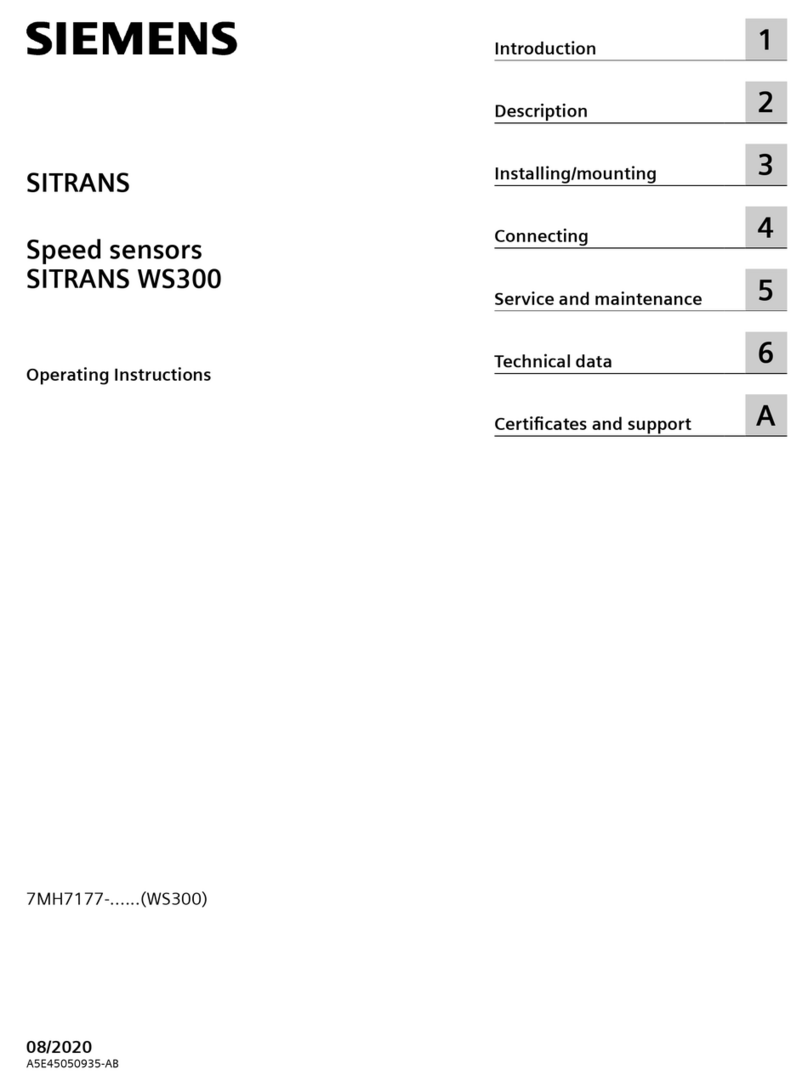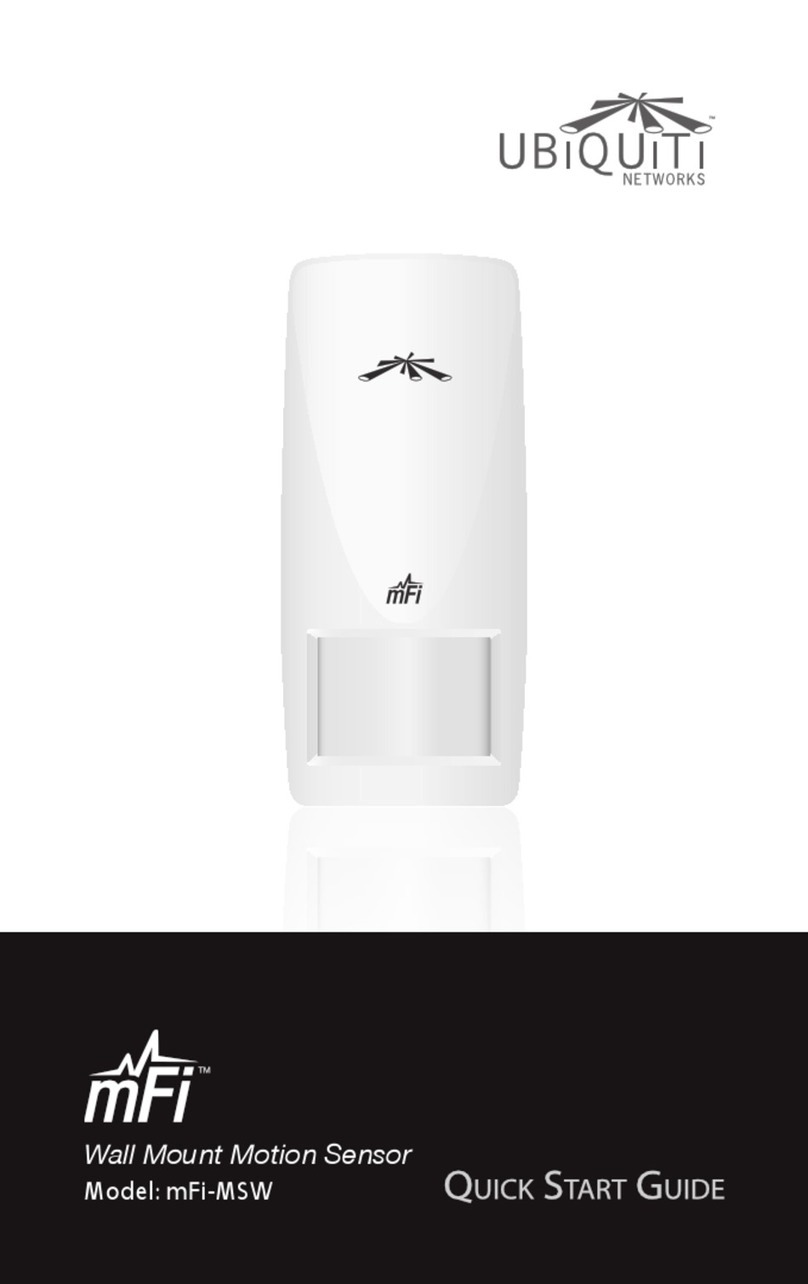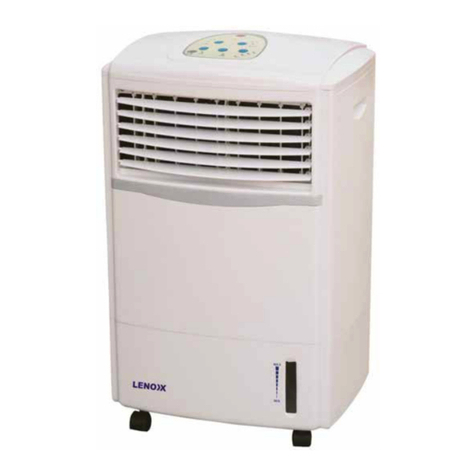Vega VEGAPULS 66 User manual

Operating Instructions
VEGAPULS 66
Probus PA
Enamelled version
Document ID: 33335

2
Contents
VEGAPULS 66 • Probus PA
33335-EN-170927
Contents
1 About this document ............................................................................................................... 4
1.1 Function ........................................................................................................................... 4
1.2 Target group ..................................................................................................................... 4
1.3 Symbols used................................................................................................................... 4
2 For your safety ......................................................................................................................... 5
2.1 Authorised personnel ....................................................................................................... 5
2.2 Appropriate use................................................................................................................ 5
2.3 Warning about incorrect use............................................................................................. 5
2.4 General safety instructions............................................................................................... 5
2.5 Safety label on the instrument .......................................................................................... 6
2.6 EU conformity................................................................................................................... 6
2.7 Fulllment of NAMUR recommendations ......................................................................... 6
2.8 Radio license for Europe .................................................................................................. 6
2.9 FCC and IC conformity (only for USA/Canada) ................................................................ 6
2.10 Installation and operation in the USA and Canada ........................................................... 7
2.11 Environmental instructions ............................................................................................... 7
3 Product description................................................................................................................. 8
3.1 Conguration.................................................................................................................... 8
3.2 Principle of operation...................................................................................................... 10
3.3 Packaging, transport and storage................................................................................... 10
3.4 Accessories and replacement parts ............................................................................... 11
4 Mounting................................................................................................................................. 13
4.1 General instructions ....................................................................................................... 13
4.2 Mounting instructions ..................................................................................................... 15
5 Connecting to power supply................................................................................................. 21
5.1 Preparing the connection ............................................................................................... 21
5.2 Connection procedure.................................................................................................... 22
5.3 Wiring plan, single chamber housing.............................................................................. 23
5.4 Wiring plan, double chamber housing ............................................................................ 25
5.5 Wiring plan, double chamber housing Ex d .................................................................... 27
5.6 Wiring plan - version IP 66/IP 68, 1 bar........................................................................... 29
5.7 Switch-on phase............................................................................................................. 29
6 Set up with the display and adjustment module PLICSCOM ............................................ 30
6.1 Short description ............................................................................................................ 30
6.2 Insert display and adjustment module............................................................................ 30
6.3 Adjustment system......................................................................................................... 31
6.4 Setup steps .................................................................................................................... 32
6.5 Menu schematic............................................................................................................. 44
6.10 Saving the parameterisation data................................................................................... 46
7 Set up with PACTware and other adjustment programs .................................................... 47
7.1 Connect the PC via VEGACONNECT ............................................................................ 47
7.2 Parameter adjustment with PACTware............................................................................ 48
7.3 Parameter adjustment with PDM.................................................................................... 49
7.4 Saving the parameterisation data................................................................................... 49
8 Maintenanceandfaultrectication...................................................................................... 50

3
Contents
VEGAPULS 66 • Probus PA
33335-EN-170927
8.1 Maintenance .................................................................................................................. 50
8.2 Rectify faults................................................................................................................... 50
8.3 Exchanging the electronics module................................................................................ 51
8.4 Software update ............................................................................................................. 52
8.5 How to proceed if a repair is necessary.......................................................................... 52
9 Dismount................................................................................................................................. 53
9.1 Dismounting steps.......................................................................................................... 53
9.2 Disposal ......................................................................................................................... 53
10 Supplement ............................................................................................................................ 54
10.1 Technical data ................................................................................................................ 54
10.2 Probus PA..................................................................................................................... 60
10.3 Dimensions .................................................................................................................... 64
10.4 Industrial property rights................................................................................................. 66
10.5 Trademark ...................................................................................................................... 66
Safety instructions for Ex areas
Take note of the Ex specic safety instructions for Ex applications.
These instructions are attached as documents to each instrument
with Ex approval and are part of the operating instructions manual.
Editing status: 2017-09-22

4
1 About this document
VEGAPULS 66 • Probus PA
33335-EN-170927
1 About this document
1.1 Function
This operating instructions manual provides all the information you
need for mounting, connection and setup of the instrument. Further-
more there are important instructions for maintenance, fault rectica-
tion, the exchange of parts and the safety of the user. Please read this
information before putting the instrument into operation and keep this
manual accessible in the immediate vicinity of the device.
1.2 Target group
This operating instructions manual is directed to trained specialist
personnel. The contents of this manual should be made available to
these personnel and put into practice by them.
1.3 Symbols used
Document ID
This symbol on the front page of this instruction refers to the Docu-
ment ID. By entering the Document ID on www.vega.com you will
reach the document download.
Information, tip, note
This symbol indicates helpful additional information.
Caution: If this warning is ignored, faults or malfunctions can result.
Warning: If this warning is ignored, injury to persons and/or serious
damage to the instrument can result.
Danger: If this warning is ignored, serious injury to persons and/or
destruction of the instrument can result.
Ex applications
This symbol indicates special instructions for Ex applications.
SIL applications
This symbol indicates instructions for functional safety which must be
taken into account particularly for safety-relevant applications.
• List
The dot set in front indicates a list with no implied sequence.
→ Action
This arrow indicates a single action.
1 Sequence of actions
Numbers set in front indicate successive steps in a procedure.
Battery disposal
This symbol indicates special information about the disposal of bat-
teries and accumulators.

5
2 For your safety
VEGAPULS 66 • Probus PA
33335-EN-170927
2 For your safety
2.1 Authorised personnel
All operations described in this operating instructions manual must
be carried out only by trained specialist personnel authorised by the
plant operator.
During work on and with the device the required personal protective
equipment must always be worn.
2.2 Appropriate use
VEGAPULS 66 is a sensor for continuous level measurement.
You can nd detailed information about the area of application in
chapter "Product description".
Operational reliability is ensured only if the instrument is properly
used according to the specications in the operating instructions
manual as well as possible supplementary instructions.
For safety and warranty reasons, any invasive work on the device
beyond that described in the operating instructions manual may be
carried out only by personnel authorised by the manufacturer. Arbi-
trary conversions or modications are explicitly forbidden.
2.3 Warning about incorrect use
Inappropriate or incorrect use of the instrument can give rise to
application-specic hazards, e.g. vessel overll or damage to system
components through incorrect mounting or adjustment. Thus dam-
age to property, to persons or environmental contamination can be
caused. Also the protective characteristics of the instrument can be
inuenced.
2.4 General safety instructions
This is a high-tech instrument requiring the strict observance of stand-
ard regulations and guidelines. The user must take note of the safety
instructions in this operating instructions manual, the country-specic
installation standards as well as all prevailing safety regulations and
accident prevention rules. For safety reasons, only the accessory
specied by the manufacturer must be used.
Depending on the model, the emitting frequencies of all radar sensors
are either in the C or K band range. The low transmitting power lies far
below the internationally permitted limit values. When the instrument
is used correctly, it presents no danger to human health. It may be
operated without restriction outside of closed metallic vessels.
The instrument must only be operated in a technically awless and
reliable condition. The operator is responsible for the trouble-free
operation of the instrument. When measuring aggressive or corrosive
media that can cause a dangerous situation if the instrument malfunc-
tions, the operator has to implement suitable measures to make sure
the instrument is functioning properly.

6
2 For your safety
VEGAPULS 66 • Probus PA
33335-EN-170927
During the entire duration of use, the user is obliged to determine the
compliance of the necessary occupational safety measures with the
current valid rules and regulations and also take note of new regula-
tions.
To avoid any danger, the safety approval markings and safety tips on
the device must also be observed and their meaning looked up in this
operating instructions manual.
2.5 Safety label on the instrument
The safety approval markings and safety tips on the device must be
observed.
2.6 EU conformity
The device fulls the legal requirements of the applicable EU direc-
tives. By axing the CE marking, we conrm the conformity of the
instrument with these directives.
You can nd the EU conformity declaration on our website under
www.vega.com/downloads.
2.7 FulllmentofNAMURrecommendations
NAMUR is the automation technology user association in the process
industry in Germany. The published NAMUR recommendations are
accepted as the standard in eld instrumentation.
The device fulls the requirements of the following NAMUR recom-
mendations:
• NE 21 – Electromagnetic compatibility of equipment
• NE 43 – Signal level for fault information from measuring transduc-
ers
• NE 53 – Compatibility of eld devices and display/adjustment
components
For further information see www.namur.de.
2.8 RadiolicenseforEurope
The instrument was tested according to the latest issue of the follow-
ing harmonized standards:
• EN 302372 - Tank Level Probing Radar
It is hence approved for use inside closed vessels in countries of the
EU.
Use is also approved in EFTA countries, provided the respective
standards have been implemented.
For operation inside of closed vessels, points a to f in annex E of
EN 302372 must be fullled.
2.9 FCC and IC conformity (only for USA/Canada)
VEGAPULS 66 is FCC and IC approved:
• FCC ID: O6QPULS6566

7
2 For your safety
VEGAPULS 66 • Probus PA
33335-EN-170927
• IC: 3892A-PS6566
Modications not expressly approved by VEGA will lead to expiry of
the operating licence according to FCC.
VEGAPULS 66 is in conformity with part 15 of the FCC regulations.
Take note of the respective operating regulations:
• This device may not cause interference, and
• The device must be resistant to interference signals, including
such that may cause undesired operating states of the device
The instrument was tested and meets the limit values for a digital
instrument of class B, according to part 15 of the FCC regulations.
The limit values are predened to ensure protection against interfer-
ing emissions during operation in industrial environments.
The instrument can generate, use and emit high frequency energy
and can generate interfering emissions if not used as described in the
operator's manual. Because interfering emissions have to be reck-
oned with when the instrument is used in residential areas, the user
must make sure necessary countermeasures are implemented.
2.10 Installation and operation in the USA and
Canada
This information is only valid for USA and Canada. Hence the follow-
ing text is only available in the English language.
Installations in the US shall comply with the relevant requirements of
the National Electrical Code (ANSI/NFPA 70).
Installations in Canada shall comply with the relevant requirements of
the Canadian Electrical Code
2.11 Environmental instructions
Protection of the environment is one of our most important duties.
That is why we have introduced an environment management system
with the goal of continuously improving company environmental pro-
tection. The environment management system is certied according
to DIN EN ISO 14001.
Please help us full this obligation by observing the environmental
instructions in this manual:
• Chapter "Packaging, transport and storage"
• Chapter "Disposal"

8
3 Product description
VEGAPULS 66 • Probus PA
33335-EN-170927
3 Product description
3.1 Conguration
The scope of delivery encompasses:
• Radar sensor
• Documentation
– Quick setup guide VEGAPULS 66
– Instructions for optional instrument features
– Ex-specic "Safety instructions" (with Ex versions)
– If necessary, further certicates
• DVD "Software", included therein
– PACTware/DTM Collection
– Driver software
Information:
In this operating instructions manual, the optional instrument features
are described. The respective scope of delivery results from the order
specication.
The VEGAPULS 66 consists of the components:
• Process tting with enamelled antenna system
• Housing with electronics, optionally available with plug connector,
optionally available with connection cable
• Housing cover, optionally available with display and adjustment
module PLICSCOM
The components are available in dierent versions.
Scope of delivery
Constituent parts

9
3 Product description
VEGAPULS 66 • Probus PA
33335-EN-170927
3
2
1
Fig. 1: VEGAPULS 66 - enamel version with plastic housing
1 Housing cover with integrated PLICSCOM (optional)
2 Housing with electronics
3 Processttingwithantennasystem
The type label contains the most important data for identication and
use of the instrument:
• Instrument type
• Article and serial number device
• Article numbers, documentation
• Technical data: Approvals, antenna type, process tting, process
seal/temperature, signal output, voltage supply, protection, protec-
tion class
With the serial number, you can access the delivery data of the instru-
ment via "www.vega.com", "VEGA Tools" and "Instrument search".
You can nd the serial number on the inside of the instrument as well
as on the type label on the outside.
This operating instructions manual applies to the following instrument
versions:
Type label
Scope of this operating
instructions manual

10
3 Product description
VEGAPULS 66 • Probus PA
33335-EN-170927
• Hardware version ≤ 1.10
• Software version ≤ 3.90
3.2 Principle of operation
VEGAPULS 66 is a radar sensor in C-band technology for continuous
level measurement.
The version with enamelled antenna is particularly suitable for
measurement of highly corrosive liquids, preferably in enamelled ves-
sels under dicult process conditions such as buildup, condensation
and foam generation as well as strong product movement.
The antenna of the radar sensor emits short radar pulses with a
duration of approx. 1 ns. These pulses are reected by the product
and received by the antenna as echoes. The transit time of the radar
pulses from emission to reception is proportional to the distance and
hence to the level. The determined level is converted into an appropri-
ate output signal and outputted as measured value.
Power supply via the Probus DP/PA segment coupler or VEGALOG
571 EP cards. A two-wire cable according to Probus specication
serves as carrier of both power and digital data transmission for mul-
tiple sensors. The instrument prole of VEGAPULS 66 corresponds to
prole specication version 3.0.
The GSD (instrument master les) and bitmap les necessary for
planning your Probus-DP-(PA) communication network are available
from the download section on the VEGA homepage "www.vega.com"
under "Services-Downloads-Software-Probus". There you can
also nd the appropriate certicates. In a PDM environment, an EDD
(Electronic Device Description) is also required to enable the full
range of sensor functions (also available as a download).A CD with
the appropriate les can be ordered via e-mail under info@de.vega.
com or by phone from one of the VEGA agencies under the order
number "DRIVER.S".
The backlight of the display and adjustment module is powered by the
sensor. Prerequisite is a certain level of operating voltage.
The data for power supply are specied in chapter "Technical data".
The optional heating requires its own operating voltage. You can nd
detailed information in the supplementary instructions manual "Heat-
ing for display and adjustment module". This function is generally not
available for approved instruments.
3.3 Packaging, transport and storage
Your instrument was protected by packaging during transport. Its
capacity to handle normal loads during transport is assured by a test
based on ISO 4180.
The packaging of standard instruments consists of environment-
friendly, recyclable cardboard. For special versions, PE foam or PE
foil is also used. Dispose of the packaging material via specialised
recycling companies.
Application area
Functional principle
Power supply and bus
communication
GSD/EDD
Packaging

11
3 Product description
VEGAPULS 66 • Probus PA
33335-EN-170927
Transport must be carried out in due consideration of the notes on the
transport packaging. Nonobservance of these instructions can cause
damage to the device.
The delivery must be checked for completeness and possible transit
damage immediately at receipt. Ascertained transit damage or con-
cealed defects must be appropriately dealt with.
Up to the time of installation, the packages must be left closed and
stored according to the orientation and storage markings on the
outside.
Unless otherwise indicated, the packages must be stored only under
the following conditions:
• Not in the open
• Dry and dust free
• Not exposed to corrosive media
• Protected against solar radiation
• Avoiding mechanical shock and vibration
• Storage and transport temperature see chapter "Supplement -
Technicaldata-Ambientconditions"
• Relative humidity 20 … 85 %
With an instrument weight of more than 18 kg (39.68 lbs) suitable and
approved equipment must be used for lifting and carrying.
3.4 Accessories and replacement parts
The display and adjustment module PLICSCOM is used for measured
value indication, adjustment and diagnosis. It can be inserted into the
sensor and removed at any time.
You can nd further information in the operating instructions "Display
and adjustment module PLICSCOM" (Document-ID 27835).
The interface adapter VEGACONNECT enables the connection of
communication-capable instruments to the USB interface of a PC. For
parameter adjustment of these instruments, an adjustment software
such as PACTware with VEGA DTM is required.
You can nd further information in the operating instructions "Interface
adapter VEGACONNECT" (Document-ID 32628).
The VEGADIS 81 is an external display and adjustment unit for VEGA
plics®sensors.
For sensors with double chamber housing the interface adapter
"DISADAPT" is also required for VEGADIS 81.
You can nd further information in the operating instructions
"VEGADIS 81" (Document-ID 43814).
PLICSMOBILE is an external GSM/GPRS radio unit for transmission
of measured values and for remote parameter adjustment of plics®
Transport
Transport inspection
Storage
Storage and transport
temperature
Lifting and carrying
PLICSCOM
VEGACONNECT
VEGADIS 81
PLICSMOBILE

12
3 Product description
VEGAPULS 66 • Probus PA
33335-EN-170927
sensors. Adjustment is carried out via PACTware/DTM and the inte-
grated USB connection.
You can nd further information in the supplementary instructions
"PLICSMOBILE T61" (Document-ID 37700).
The protective cover protects the sensor housing against soiling and
intense heat from solar radiation.
You will nd additional information in the supplementary instructions
manual "Protective cover" (Document-ID 34296).
Electronics module "VEGAPULS series 60" is a replacement part for
radar sensors of VEGAPULS series 60. A dierent version is available
for each type of signal output.
You can nd further information in the operating instructions "Elec-
tronics module VEGAPULS series 60" (Document-ID 30176).
Protective cover
Electronics module

13
4 Mounting
VEGAPULS 66 • Probus PA
33335-EN-170927
4 Mounting
4.1 General instructions
Select an installation position you can easily reach for mounting and
connecting as well as later retrotting of a display and adjustment
module. The housing can be rotated by 330° without the use of any
tools. You can also install the display and adjustment module in four
dierent positions (each displaced by 90°).
Use the recommended cables (see chapter "Connecting to power
supply") and tighten the cable gland.
You can give your instrument additional protection against moisture
penetration by leading the connection cable downward in front of the
cable entry. Rain and condensation water can thus drain o. This ap-
plies mainly to outdoor mounting as well as installation in areas where
high humidity is expected (e.g. through cleaning processes) or on
cooled or heated vessels.
To maintain the housing protection, make sure that the housing lid is
closed during operation and locked, if necessary.
Make sure that the degree of contamination specied in chapter
"Technical data" meets the existing ambient conditions.
Fig. 2: Measures against moisture ingress
Metric threads
In the case of instrument housings with metric thread, the cable
glands are screwed in at the factory. They are sealed with plastic
plugs as transport protection.
You have to remove these plugs before electrical connection.
NPTthread
In the case of instrument housings with self-sealing NPT threads, it is
not possible to have the cable entries screwed in at the factory. The
free openings for the cable glands are therefore covered with red dust
protection caps as transport protection.
Prior to setup you have to replace these protective caps with ap-
proved cable glands or close the openings with suitable blind plugs.
The reference plane for the measuring range is the lower edge of the
ange.
Installation position
Moisture
Cableentries-NPT
thread
Cable glands
Measuring range

14
4 Mounting
VEGAPULS 66 • Probus PA
33335-EN-170927
1 32
100%
0%
4
Fig. 3: Measuring range (operating range) and max. measuring distance
1 full
2 empty (max. measuring distance)
3 Measuring range
4 Reference plane
Information:
If the medium reaches the antenna, buildup can form on it and cause
faulty measurements later on.
The emitted radar impulses of VEGAPULS 66 are electromagnetic
waves. The polarisation plane is the direction of the electrical share.
Their position is marked on the instrument.
1
Fig. 4: Position of the polarisation plane of VEGAPULS 66
1 Marking hole
Make sure that all parts of the instrument coming in direct contact
with the process, especially the sensor element, process seal and
process tting, are suitable for the existing process conditions, such
Polarisation plane
Suitability for the process
conditions

15
4 Mounting
VEGAPULS 66 • Probus PA
33335-EN-170927
as process pressure, process temperature as well as the chemical
properties of the medium.
You can nd the specications in chapter "Technical data" and on the
nameplate.
The instrument is suitable for standard and extended ambient condi-
tions acc. to DIN/EN/IEC/ANSI/ISA/UL/CSA 61010-1.
Instruments with enamel coating should be treated very carefully and
shocks should be avoided. Unpack VEGAPULS 66 directly before
installation. Insert VEGAPULS 66 carefully into the vessel opening
and avoid touching any sharp vessel parts.
4.2 Mounting instructions
When mounting the VEGAPULS 66, keep a distance of at least
500 mm (19.69 in) to the vessel wall. If the sensor is installed in the
center of dished or round vessel tops, multiple echoes can arise.
These can, however, be suppressed by an appropriate adjustment
(see chapter "Setup").
If you cannot maintain this distance, you should carry out a false
signal suppression during setup. This applies particularly if buildup on
the vessel wall is expected. In such cases, we recommend repeating
the false signal suppression at a later date with existing buildup.
> 500 mm
(19.69
")
Fig. 5: Mounting on round vessel tops
1 Reference plane
2 Vessel center or symmetry axis
In vessels with conical bottom it can be advantageous to mount the
sensor in the centre of the vessel, as measurement is then possible
down to the bottom.
Suitability for the ambient
conditions
Enamel coating
Installation position

16
4 Mounting
VEGAPULS 66 • Probus PA
33335-EN-170927
Fig.6:Vesselwithconicalbottom
Do not mount the instruments in or above the lling stream. Make sure
that you detect the product surface, not the inowing product.
Fig.7:Inowingliquid
The socket piece should be dimensioned in such a way that the an-
tenna end protrudes at least 10 mm (0.4 in) out of the socket.
Inowingmedium
Mounting socket

17
4 Mounting
VEGAPULS 66 • Probus PA
33335-EN-170927
ca. 10 mm
Fig. 8: Recommended socket mounting
In liquids, direct the sensor as perpendicular as possible to the prod-
uct surface to an achieve optimum measurement.
Fig.9:Alignmentinliquids
The mounting location of the radar sensor should be a place where no
other equipment or xtures cross the path of the microwave signals.
Vessel installations such as for example, ladders, limit switches, heat-
ing spirals, struts etc. can cause false echoes that interfere with the
useful echo. Make sure when planning your measuring site that the
radar signals have a "clear view" to the measured product.
In case of existing vessel installations, a false signal suppression
should be carried out during setup.
If large vessel installations such as struts or supports cause false
echoes, these can be attenuated through supplementary measures.
Small, inclined sheet metal baes above the installations scatter the
radar signals and prevent direct interfering reections.
Fig.10:Coverat,large-areaproleswithdeectors
If there are agitators in the vessel, a false signal suppression should
be carried out with the agitators in motion. This ensures that the
Sensor orientation
Vessel installations
Agitators

18
4 Mounting
VEGAPULS 66 • Probus PA
33335-EN-170927
interfering reections from the agitators are saved with the blades in
dierent positions.
Fig. 11: Agitators
Through the action of lling, stirring and other processes in the vessel,
dense foams which considerably damp the emitted signals may form
on the product surface.
If foam is causing measurement errors, the largest possible radar
antenna should be used.
As an alternative, sensors with guided microwave can be used. These
are unaected by foam generation and are best suited for such ap-
plications.
By using a standpipe, the inuence of vessel installations and turbu-
lence can be excluded. Under these prerequisites, the measurement
of products with low dielectric constant (from 1.6) is possible.
Surge or bypass tubes must extend all the way down to the requested
min. level, as measurement is only possible within the tube.
Surge pipe
Make sure you provide the necessary upper vent hole in the surge
pipe. The hole must be aligned so that it and the polarisation marking
on the sensor ange are in the same plane (see illustration: "Pipe
antenna system in a tank").
Foam generation
Measurement in the
standpipe (surge or by-
pass tube)

19
4 Mounting
VEGAPULS 66 • Probus PA
33335-EN-170927
max.
min.
2
1
Fig.12:Pipeantennasysteminatank.Theventholeinthesurgepipemustbe
in one plane with the polarisation marking on the sensor.
1 Marking of the polarisation direction
2 Vent hole max. ø 5 mm (0.2 in)
If possible, the diameter of the sensor antenna should correspond
to the inner diameter of the tube. With VEGAPULS 66 this is approx.
50 mm (1.969 in) depending on the antenna. The sensor can be used
with tube diameters between 50 … 250 mm (1.969 … 9.843 in).
Bypass pipe
As an alternative to the surge pipe in the vessel, a tube system out-
side of the vessel is possible as a bypass tube. Select during setup
the function "Bypasstube".
Align the sensor in such a way that the polarisation marking on the
sensor ange is in the same plane as the tube holes or the tube con-
nection openings (see illustration: "VEGAPULSinabypasstube").

20
4 Mounting
VEGAPULS 66 • Probus PA
33335-EN-170927
100%
0%
1
> 500 mm
Fig.13:VEGAPULS66inabypasstube.Thepolarisationmarkingonthe
processttingmustbeinoneplanewiththetubeholesorthetubeconnection
openings.
1 Marking of the polarisation direction
When the sensor is mounted on a bypass tube, the distance from
VEGAPULS 66 to the upper tube connection should be approx.
500 mm (19.69 in) or more. In case of extremely rough tube inner
walls, you should use an inserted tube (tube in tube) or a radar sensor
with tube antenna.
Information:
With VEGAPULS 66 in ange version, the polarisation plane is always
in the center between two ange holes.
Other manuals for VEGAPULS 66
17
Table of contents
Other Vega Accessories manuals
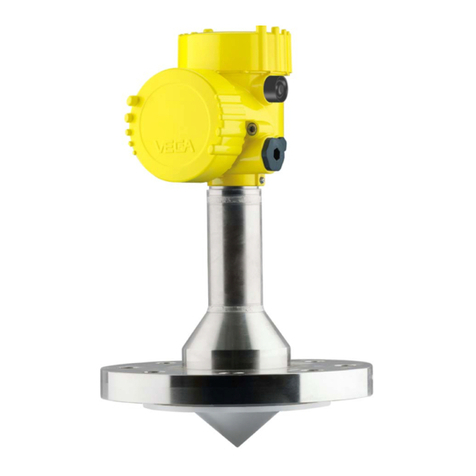
Vega
Vega VEGAPULS 63 User manual
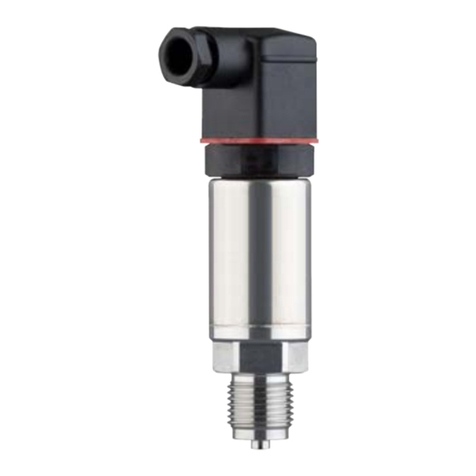
Vega
Vega VEGABAR 18 User manual
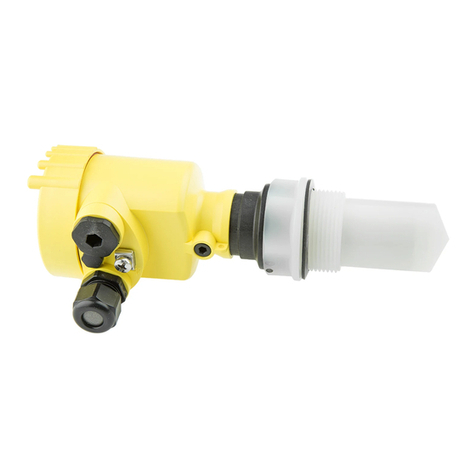
Vega
Vega VEGAPULS 61 User manual
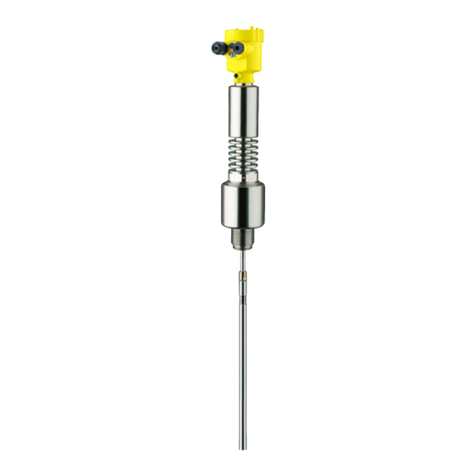
Vega
Vega VEGAFLEX 86 User manual

Vega
Vega VEGAPULS 66 User manual
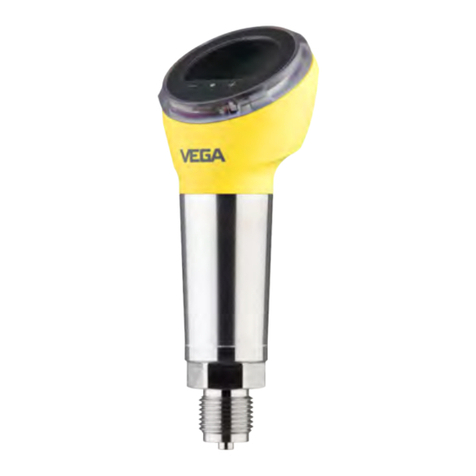
Vega
Vega VEGABAR 39 User manual

Vega
Vega VEGAFLEX 86 User manual
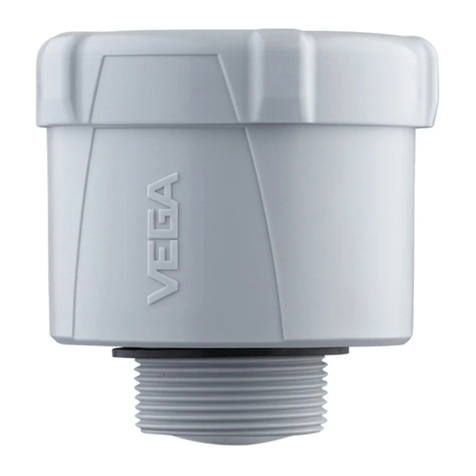
Vega
Vega VEGAPULS Air 41 User manual
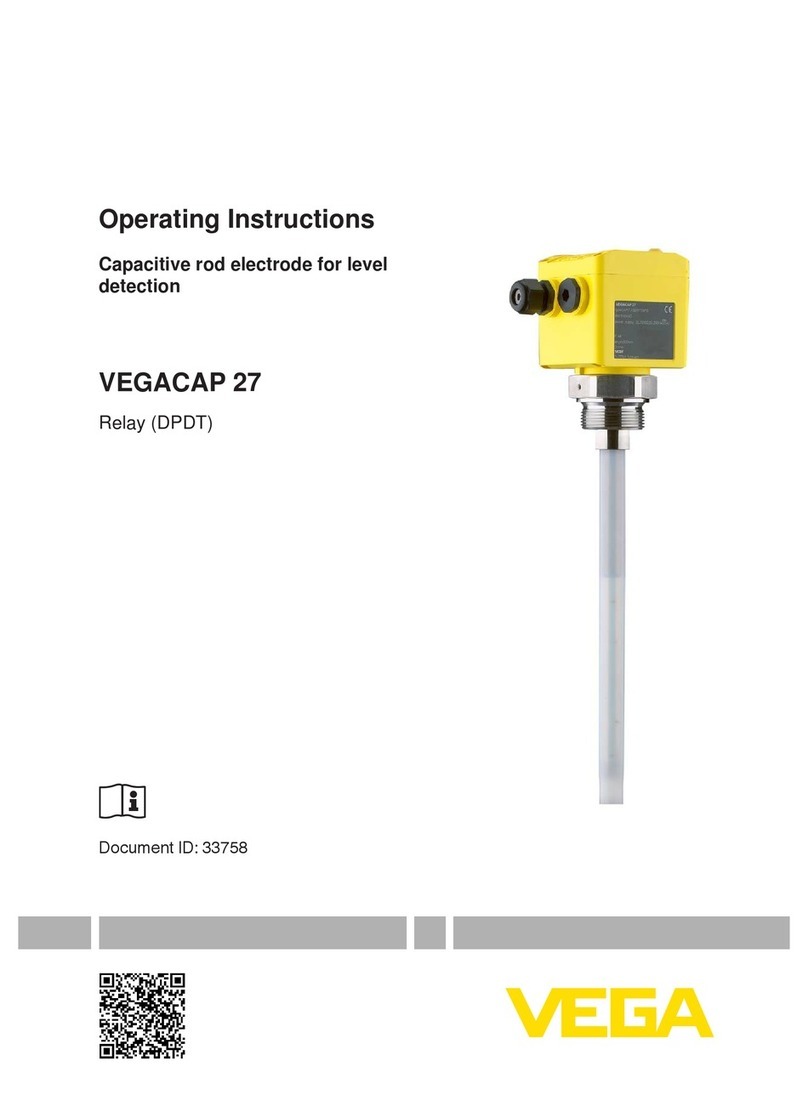
Vega
Vega VEGACAP 27 User manual

Vega
Vega VEGAPULS 69 User manual
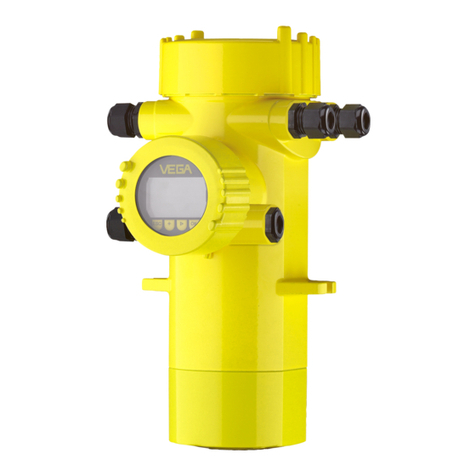
Vega
Vega MINITRAC 31 User manual
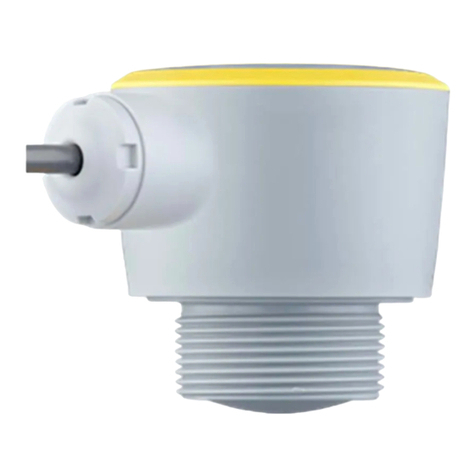
Vega
Vega VEGAPULS C 22 User manual

Vega
Vega VEGASON 61 User manual

Vega
Vega VEGASWING 61 User manual

Vega
Vega VEGAMET 391 User manual

Vega
Vega VEGAFLEX 65 User manual

Vega
Vega vegaflex 83 User manual

Vega
Vega VEGABAR 82 User manual
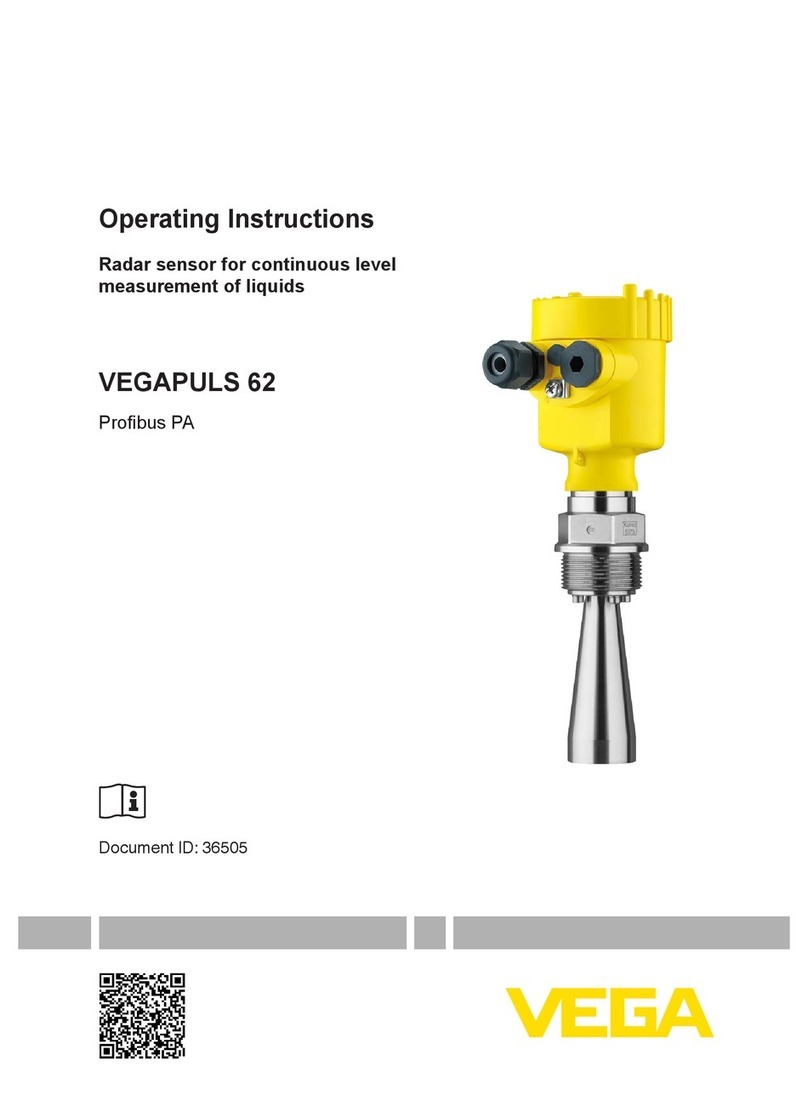
Vega
Vega VEGAPULS 62 User manual
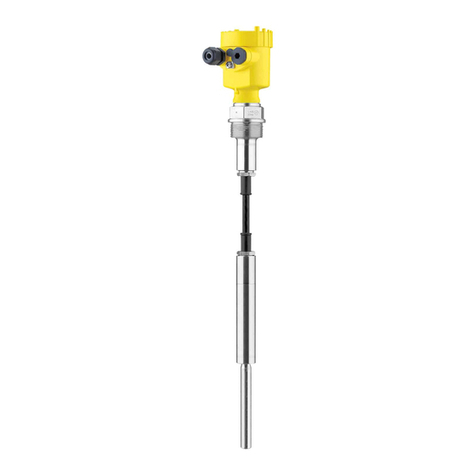
Vega
Vega VEGAVIB 62 User manual



